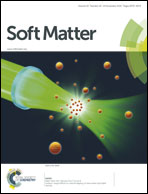Competitive coordination control of the AIE and micro states of supramolecular gel: an efficient approach for reversible dual-channel stimuli-response materials†
Abstract
An organogelator (G2) based on multi self-assembly driving forces, fluorescent signal groups and coordination binding sites was designed and synthesized. G2 could form a stable Cd2+-coordinated supramolecular metallogel (CdG) accompanied by strong brilliant blue aggregation-induced fluorescence emission (AIE). By the competitive coordination of Cd2+ with gelator and I−, the AIE of CdG could be reversibly switched “on-off-on” under gel–gel states via alternative adding I− and Cd2+ into CdG. Interestingly, because of the competitive coordination of Cd2+ with I−, the micro structure of the CdG xerogel carried out dramatic changes and formed lots of micro cavities. These micro cavities could absorb iodine vapour and caused the color of CdG xerogel change from white to brown. The CdG could not only act as a convenient high selective and sensitive I− detection test kit (detection limit for I− is 1.0 × 10−7 M) but also as rewritable dual-channel security display materials.


 Please wait while we load your content...
Please wait while we load your content...